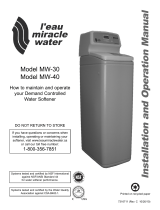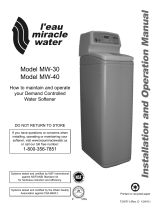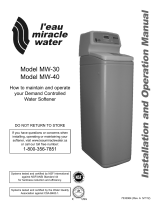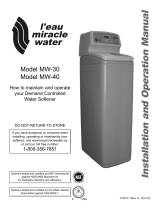Page is loading ...

Chlorine electrolysis system
CHLORINSITU
®
IIa 60 ... 300 g/h
Maintenance instructions
Target group: Technical personnel.
These maintenance instructions are only valid in conjunction with the installation and operating instructions for the CHLOR‐
INSITU
®
IIa 60 - 300.
EN
Original operating instructions (2006/42/EC)981159 BA CI 020 09/20 EN
Please carefully read these operating instructions before use. · Do not discard.
The operator shall be liable for any damage caused by installation or operating errors.
The latest version of the operating instructions are available on our homepage.

Table of contents
1
Safety.................................................................................... 3
2
Maintenance of Chlorinsitu
®
IIa 60 - 300 g/h........................ 4
2.1 Warning information...................................................... 4
2.2 Recommendation for the pre-maintenance weeks....... 4
2.3 Maintenance intervals................................................... 4
2.4 You will need the following for maintenance................. 4
2.4.1 Protective clothing..................................................... 4
2.4.2 Contents of the capacity-specific “Maintenance
package 1” (annual maintenance):
............................ 5
2.4.3 Contents of the capacity-specific “Maintenance
package 3” (3-yearly maintenance):.......................... 5
2.4.4
Contents of Chlorinsitu
®
lla service kit.......................
5
2.4.5 Hydrochloric acid 5 %................................................ 5
2.4.6 Collecting vessel........................................................ 5
2.4.7 10-litre bucket............................................................ 5
2.4.8 20-litre canister.......................................................... 6
2.4.9 Service passwords..................................................... 6
2.5 Before undertaking maintenance work: Check and
note the following.......................................................... 6
2.6 How often is acid cleaning needed?............................. 6
3 Annual and 3-yearly maintenance steps when using MP1
and MP3................................................................................ 7
4 Maintenance check-list....................................................... 19
Table of contents
2

1 Safety
WARNING!
Danger from hazardous substances!
Possible consequence: Fatal or very serious inju‐
ries.
Please ensure when handling hazardous sub‐
stances that you have read the latest safety data
sheets provided by the manufacture of the haz‐
ardous substance. The actions required are
described in the safety data sheet. Check the
safety data sheet regularly and replace, if neces‐
sary, as the hazard potential of a substance can be
re-evaluated at any time based on new findings.
The system operator is responsible for ensuring
that these safety data sheets are available and that
they are kept up to date, as well as for producing
an associated hazard assessment for the worksta‐
tions affected.
n Maintenance may only be carried out by authorised technical
personnel.
n These maintenance instructions are only valid in conjunction
with the “Installation and operating instructions for the chlorine
electrolysis system CHLORINSITU
®
IIa”.
Safety
3

2
Maintenance of Chlorinsitu
®
IIa 60 - 300 g/h
2.1
Warning information
WARNING!
Danger from hazardous substances!
Possible consequence: Fatal or very serious inju‐
ries.
Please ensure when handling hazardous sub‐
stances that you have read the latest safety data
sheets provided by the manufacture of the haz‐
ardous substance. The actions required are
described in the safety data sheet. Check the
safety data sheet regularly and replace, if neces‐
sary, as the hazard potential of a substance can be
re-evaluated at any time based on new findings.
The system operator is responsible for ensuring
that these safety data sheets are available and that
they are kept up to date, as well as for producing
an associated hazard assessment for the worksta‐
tions affected.
WARNING!
You are working with chemicals here:
– Sodium hypochlorite 0.9% (NaOCl)
–
Hydrochloric acid 5% (HCI)
– Salt (NaCl)
Therefore:
– Never mix NaOCI with HCI as this produces
toxic gas.
– Pay attention to the material safety data
sheets.
– Wear effective personal protective equipment.
2.2 Recommendation for the pre-maintenance weeks
In the weeks leading up to maintenance, preferably fill only as
much salt into the brine storage tank as you will need during the
final weeks before maintenance.
2.3
Maintenance intervals
n annually
n carry out an additional maintenance every 3 years
2.4 You will need the following for maintenance
2.4.1
Protective clothing
Protective clothing:
n safety goggles,
n gloves,
Maintenance of Chlorinsitu
®
IIa 60 - 300 g/h
4

n appropriate clothing and shoes,
n refer to the material safety data sheet.
2.4.2
Contents of the capacity-specific “Maintenance package 1” (annual maintenance):
1 - Test kit for softened water < 0.1 °dH,
2 - Water filter,
3 - Filter mat for the fan,
4 - Spare parts kit: Brine metering, complete,
5 - Flat seals, sensor, drain,
6 - Various sealing rings, 3-part PVC couplings.
2.4.3 Contents of the capacity-specific “Maintenance package 3” (3-yearly maintenance):
1 - Contents as per “Maintenance package 1”, but in addition:
2 - Control valve for water metering
3 - Measuring cartridge, sensor, drain
4 - Maintenance kit for the softener
2.4.4
Contents of Chlorinsitu
®
lla service kit
1 - Measuring cylinder, 500 ml, to calibrate the capacity of the
brine metering pump.
2 - Adapter kit for acid cleaning and calibration of the capacity of
the brine metering pump.
3 - Wrench (spanner) for maintenance of the softener.
2.4.5 Hydrochloric acid 5 %
Tab. 1: Required quantity of hydrochloric acid:
Type / System capacity, g/h 60 120 180 240 300
Quantity of HCI, in l 3 6 9 12 15
2.4.6 Collecting vessel
A collecting vessel to collect the water while the pipework is open.
2.4.7 10-litre bucket
10-litre bucket for water and brine.
Maintenance of Chlorinsitu
®
IIa 60 - 300 g/h
5

2.4.8 20-litre canister
Only with acid cleaning: 20-litre canister to dispose of the diluted
hydrochloric acid.
2.4.9
Service passwords
Your sales partner will provide you with the service password.
2.5 Before undertaking maintenance work: Check and note the following
1. Check the content of the alarm sequence of events in the
‘Service’
menu. If required: Delete the alarm messages.
2. Note down the value of the “Production hours” counter in the
‘Service’
menu.
3. Carry out a visual inspection of the unit including checking for
any leaks.
4. Carry out a visual check of the discharge line for diluted
hydrogen and the outlet into the outdoor air.
5. Allow the system to produce for a minimum of 5 minutes.
Then raise the level switch in the product storage tank and
note the following:
1 - The time elapsed since the last start. A minimum of 5
minutes.
2 - Does the system stop as soon as the operator opens
the door of the control cabinet?
3 - Take a sample of the softened water – the hardness
should be < 0.05°dH.
4 - Cell voltage
5 - Cell current
6 - Cell temperature at the inlet
7 - Cell temperature at the outlet
8 - Flow at the input
9 - Flow at the output
10 - Which salt is used? Does it comply with the specifica‐
tion?
6. Is the liquid level of the brine storage tank normal?
1 - The liquid level should be below the overflow point.
2 - Does the valve close after filling?
3 - Is the liquid level high enough (> 20 cm)?
2.6 How often is acid cleaning needed?
The cells need to be cleaned with acid annually.
Maintenance of Chlorinsitu
®
IIa 60 - 300 g/h
6

3 Annual and 3-yearly maintenance steps when using MP1 and
MP3
1. Use the
[START/STOP]
key in the main menu to stop the
system.
2. Rinsing the suction side:
1 - Remove both foot valves from the brine storage tank.
2 - Insert both suction hoses into a 10-litre bucket filled with
water and rinse the suction hoses.
3 - Replace both foot valves.
4 - Put both foot valves back into the bucket.
5 - Turn the rotary switch of the brine pump from
EXTERNAL to “100 %” operating mode to rinse the brine
out of the system.
6 - Vent the brine pump, if necessary.
3. In the
‘Service’
menu, press the
[right arrow key]
and select
‘Rinse’
:
Spülen
Säurereinigung
Sole-Pumpe
Service
B1107
ð
The cell is rinsed with water for 10 minutes, no chlorine is
produced and no brine is metered. The brine pump works
as the brine pump is still in manual “100 %” operating
mode.
Annual and 3-yearly maintenance steps when using MP1 and MP3
7

4. Service the optional chlorine metering pump:
WARNING!
The chlorine metering pump and the hoses
are filled with NaOCI.
– Take precautionary measures as per the
material safety data sheet.
1 - De-pressurise the chlorine metering hose.
2 - If necessary, empty the product storage tank in advance
and fill with water.
WARNING! Never mix the product with an acid as
this will produce chlorine gas.
3 - Set the chlorine metering pump to manual
‘100 %’
oper‐
ating mode; the pump and hoses will fill up with water.
4 - You can remove the pump from the storage tank to be
able to work more easily on the liquid end.
5 - Carry out maintenance as per the operating instructions
for the metering pump.
Replace the diaphragm and valves etc.
6 - Replace the foot valve in the product storage tank.
7 - Bleed the chlorine metering pump and check that it is
working properly.
8 - Wipe away any NaOCI that has escaped, rinse and
clean the surfaces with water.
5. Move the rotary switch of the brine metering pump to STOP.
ð
The pump and hoses are filled with water instead of with
NaOCI.
6. Switch off the external power supply as soon as cell rinsing
has ended.
The cell(s), pipes, sensors etc. are now filled with water
instead of with brine or NaOCI.
7. Disconnect the water supply and open and close the water
softener test valve to bring the system to atmospheric pres‐
sure.
B1189
Annual and 3-yearly maintenance steps when using MP1 and MP3
8

8.
B1111
9.
B1190
Annually: clean the venturi pipe at the top.
Every 3 years: Replace the plunger, seal and washer set.
10. Connect up the power supply but do not yet connect up the
water supply.
Replacing the water filter
Maintain the softener in line with its
operating instructions:
Annual and 3-yearly maintenance steps when using MP1 and MP3
9

11.
B1191
Disconnect the brine pipework from the inlet of the cells.
Have a vessel ready to collect any water that escapes.
You can remove the 4x6 mm water hose from the water con‐
trol valve (clip-on attachment).
1 - Replace the O-ring on the 3-part coupling of the cell
inlet.
2 - Replace the brine injection valve.
3 - Carry out maintenance on the brine metering pump as
per the operating instructions for the brine metering
pump.
You can remove the brine metering pump from the
internal product storage tank to be able to work more
easily on the liquid end.
Replace the diaphragm and valves etc.
12. Reconnect the brine supply line if you wish to carry out acid
cleaning.
13.
B1112
Remove the pipework from under the cells.
1 - Have a vessel ready to collect water that will immediately
escape.
2 - Replace all sealing rings on the 3-part couplings.
3 - Reconnect the pipes, with the exception of the pipe on
the far right.
Annual and 3-yearly maintenance steps when using MP1 and MP3
10

14.
B1192
Remove the lower pipe from the far right cell and replace all
sealing rings on the 3-part couplings.
Do not connect the pipe now if you are plan‐
ning acid cleaning.
Annual and 3-yearly maintenance steps when using MP1 and MP3
11

15.
B1193
Open both flow sensor threaded connectors in the outlet.
CAUTION!
– Pay attention to the flow sensor’s meas‐
uring cartridge, as it can fall out.
–
A direction arrow is located on the flow
sensor. The direction arrow must be
facing upwards.
– Fundamentally do not use any tools to
tighten the 3-part couplings or hex
screws. Tightening them hand-tight suf‐
fices.
1 - Loosen the pipework between the cells and the flow
sensor (left part of the figure above) and remove this
pipework. The temperature sensor must remain in the
line.
2 - Replace all O-rings in the 3-part couplings.
3 - Remove the 2 hex screws from the sensor, and replace
the 2 flat seals above and below the flow sensor - see
figure below.
CAUTION! Pay attention to the flow sensor’s measuring
cartridge, as it can fall out.
Replace the measuring cartridge in the sensor every 3
years.
4 - Replace the 2 hex screws, but do not yet fit the sensor.
B1113
Annual and 3-yearly maintenance steps when using MP1 and MP3
12

16.
B1194
Replace all O-rings in the 3-part couplings (32 mm) con‐
nected to the product storage tank.
17. Replace the water control valve, every 3 years.
B1114
You can simply unclip the hoses (clip system).
Connector Label at side
Valve outlet 2
Valve inlet 1
18.
B1189
Switch on the water supply again:
1 - Slowly open the water supply valve.
2 - Slowly open the valve for softened water to release the
air.
Air is trapped in the water filter, which then migrates into
the water softener.
19.
If you wish to skip acid cleaning, then skip to
Ä Procedure
instructions on page 7
.
Annual and 3-yearly maintenance steps when using MP1 and MP3
13

20.
B1195
If you wish to carry out acid cleaning, connect the adapter kit
with hose to the outlet of the last cell – far right cell.
WARNING!
Never allow the adapter hose to enter the
product storage tank, as hydrochloric acid
and hypochlorite could produce toxic chlorine
gas.
– Therefore keep the lid of the product
storage tank closed.
Route the adapter hose into an empty 20-litre canister.
21. 1 - Route the suction hose of the brine metering pump into
the 5 % hydrochloric acid.
2 - Turn the rotary dial on the brine metering pump from
STOP to “100 %”.
3 - After 60 minutes, turn the rotary dial on the brine
metering pump from “100 %” to “STOP”.
4 - Leave the adapter hose in the canister.
ð
CAUTION!
The 20-litre canister now contains hydro‐
chloric acid with a concentration of less
than 5 %.
22. 1 - Route the suction hose into the bucket filled with water.
2 - Start up the brine metering pump, by turning the dial
from STOP to
"100 %" for 9 minutes.
As soon as the brine metering pump has started up,
press the
‘Rinse cells’
key on the system.
3 - After 9 minutes stop the brine metering pump by turning
the rotary dial from 100 % to EXTERNAL.
Tab. 2: The additional volume of rinsing water in the canister after 9 minutes is approximately:
Type / System capacity, g/h 60 120 180 240 300
Rinsing water, in l 2 3 4 5 6
Acid cleaning of the cell(s):
Rinse the cell(s) and brine metering
pump with water:
Annual and 3-yearly maintenance steps when using MP1 and MP3
14

23. Dispose of or neutralise the hydrochloric acid needed for
rinsing.
24.
B1196
Always replace the outlet line on the cell(s) and the line to the
internal product storage tank.
25. Check and clean the brine storage tank.
You will need to clean the brine storage tank if there is a lot
of dirt in the brine storage tank or if a hard layer of
≧ 5 cm of
salt impenetrable for water has formed on the base.
26.
B1189
Switch on the water supply again:
1 - Slowly open the water supply valve.
2 - Slowly open the valve for softened water to carefully
release the air.
Air is trapped in the water filter, which then migrates into
the water softener.
27. Start up the brine metering pump again:
1 - Route the suction hose of the brine metering pump into
the brine storage tank.
2 - Route the suction hose of the softener into the brine
storage tank again.
3 - Now replace both foot valves with new foot valves.
4 - If necessary: bleed the brine metering pump.
5 - Turn the rotary dial on the brine metering pump to
EXTERNAL.
Annual and 3-yearly maintenance steps when using MP1 and MP3
15

28. Prepare for calibration of the brine metering pump:
B1197
1 - Connect the adapter to the inlet line for brine and route
the hose into the measuring cylinder filled with brine to
ensure that the lack of injection valve does not distort
calibration.
2 - Make sure that the adapter is upright and at the highest
position to enable the air to flow out.
3 - Turn the rotary dial on the brine metering pump to “100
%”; if necessary, remove the bleed valve on the pump
and the bleed hose.
4 - Allow the pump to run for at least 2 minutes to allow
brine to enter the line.
5 - Turn the rotary dial on the brine metering pump to
EXTERNAL.
6 - Note the liquid level in the measuring cylinder.
B1198
Annual and 3-yearly maintenance steps when using MP1 and MP3
16

29. Calibrate the brine metering pump:
Sole-Pumpe
Gemessenes Volumen ist:
Die Produktion abstellen und dann die Taste
drücken. Die
Sole-Pumpe beginnt für 10 min
zu pumpen. Sobald die Pumpe stoppt,
das Volumen messen und unten eintragen.
572 s
200 ml
B1109
1 - In the
‘Service’
menu, use the
[right arrow key]
to press
the
[key]
with the metering pump.
2 - Follow the instructions on the display.
3 - The bring pump is calibrated once the volume measured
has been entered in the display.
4 - Turn the rotary dial on the brine metering pump to
EXTERNAL.
5 - Reconnect the inlet line for the brine to the cell.
6 - If necessary: wipe away any brine that has escaped or
rinse it away with water.
30. Replace the filter mat.
B1110
31. In the
‘Settings’
menu, press the
[Fill cell]
key, filling the cells
for approximately 5 minutes.
32. Press the
[START/STOP]
key and let the unit run for a min‐
imum of 5 minutes.
ð
A power supply error can occur (
‘Voltage too high’
or
‘Current strength too low’
). Simply reset the alarm and
restart the unit.
A third attempted start should be successful.
Filling the cell(s) with brine
Restarting NaOCI production
Annual and 3-yearly maintenance steps when using MP1 and MP3
17

33.
Gesamtproduktionsstunden
Reset Produktionsstunden
0027659 h
Produktionsstunden seit
letzter Wartung
Tage bis nächste Wartung
Gesamtproduktion
B1108
0001272 h
0317 Tage
In the
‘Service
è
Total production’
menu, press
[Reset production hours]
.
34. Note down the data for the cells.
Allow the system to produce continuously for a minimum of 5
minutes. That suffices for an initial test. Complete warm-up of
the cells would need 30 minutes.
Note down the following:
1 - Time elapsed since the last start (a minimum of 5
minutes)
2 - Cell voltage
3 - Cell current
4 - Cell temperature at the inlet
5 - Cell temperature at the outlet
6 - Flow at the input
7 - Flow at the output
8 - Take a sample of the softened water – the hardness
should be < 0.05°dH.
35. Use the orange screw lid to seal the product storage tank.
Reset
‘Production hours’
Annual and 3-yearly maintenance steps when using MP1 and MP3
18

4 Maintenance check-list
CIIa serial number:
CIIa capacity:
Commissioning date:
Maintenance interval:
n annually
n every 3 years
n every 5 years
Performed by:
Date:
Remarks:
No. Re: OK
1 Pre-maintenance performance values:
Cell current [A]:
Cell voltage [V]:
Temperature at cell input [°C]:
Temperature at cell output [°C]:
Cell flow on [l/h]:
Cell flow off [l/h]:
Production hours [hours]:
Days until next maintenance [days]:
Water hardness < 0.05 °dH? [yes / no]:
2 Alarm messages to be noted?
3 Visual check and visual leaks to be noted?
4 Does the salt used comply with the specification?
5 Safety in relation to hydrogen:
Visual check of the extract air pipe for diluted hydrogen
Visual check of the outlet point for diluted hydrogen to the outside
Maintenance check-list
19

No. Re: OK
Room air suction opening free (> 225 cm
2
)?
Does the unit stop after the cabinet door is opened?
6 Replace the water filter.
7 Change or clean the air intake filter.
8 At least every 3 years: Cleaning of the cell(s) with acid is recommended but is not nec‐
essary in each case.
9 Maintain the lye metering pump.
10 Replace the lye injection valve.
11 Calibrate the lye metering pump.
12 If fitted: maintain the chlorine metering pump.
13 Annually: replace the foot valve in the internal chlorine tank – recommended.
14 Replace sealing rings in the three-part couplings:
Do not use any tools to tighten the three-part couplings.
n at the inputs and outputs of the cells
n downstream of the far right / last cell
n 32 mm pipe on the internal chlorine tank
15 Replace around the outlet sensor:
n O-rings on the three-part coupling upstream and downstream of the sensor
n Flat seal upstream and downstream of the sensor. Manually tighten rotary sensor
16 Salt tank:
n Check for hard salt crust on the base.
n Check for dirt on the base.
n Clean the tank if needed.
n Replace both foot valves.
17 Has the test kit for the water hardness not yet run out?
18 Every 3 years: Replace the measuring turbine cartridge of the outlet sensor.
19 Every 3 years: Replace the control valve for water metering.
20 Every 3 years: Maintain the water softener.
Replace the plunger, seals and washers and clean the nozzle.
21 Every 5 years: Replace the housing fan.
22 Every 5 years: Replace the cells - recommended.
23 Every 5 years: Replace the float switch of the chlorine tank, recommended.
24 Reset the maintenance counter to 365 days.
Maintenance check-list
20
/



